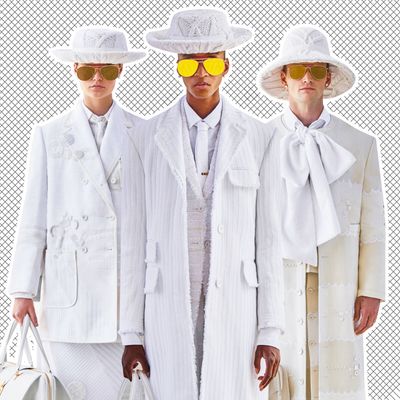
Thom Browne has seemed to be from the moon for so long now that a lunar fashion show feels like a homecoming. We’re a long way from Paris, where Browne usually presents his collections, in shows that are famously baroque. If anyone was likely to feel the pinch of COVID-related restrictions on spectacle and gathering, it was he. “I can’t wait to get back and be able to do things in person,” he said ahead of yesterday’s premiere — no death of the fashion show for him. But until then, the show must go on, digitally. For his spring men’s and women’s collections — genderless collections, he specified — Browne produced a video instead, a 22nd-century dispatch from an Olympic Games on the moon.
It suits him. For a designer who can seem a little straitlaced and stern — he’d freshly touched up his own buzz cut when we spoke, though he hadn’t yet talked his partner, Met curator Andrew Bolton, into accepting a matching one — Browne is one of the few designers to insist that fashion could be, and maybe even should be, funny. Rather than put on a self-serious procession, Browne booked comedian Jordan Firstman, whose impressions and “secret-sharing” Instagram Stories have become quarantine hits, to host the 9-minute clip. “Welcome to the 2132 ceremonies from wherever you’re tuning in from,” Firstman mugs, “whether it be miles above the Earth’s surface in New Paree, or the ice-cold surface of Jupiter.” (Model Grace Mahary plays his correspondent in the field.)
The Olympic theme fit the collection. Browne is always interested in the way that tailoring — his métier — intersects with sportswear. For this collection, he looked back to the 1920s, bringing back sack dresses and long, pleated skirts with his usual cardigans and snug tailored jackets, drawing out the silhouette to be longer and looser, a nod to the uncorseting of the Jazz Age. Suzanne Lenglen, the great French tennis pro of the day, was a muse; Lenglen, called “La Divine,” created a scandal with her on-court outfits, famously commissioned from Jean Patou. He set his Olympics in the Los Angeles Memorial Coliseum, built in 1923, and home to the 1932 and 1984 Summer Games. There are a handful of real-life Olympians who appear, along with models, to process up and down the stadium stairs. (The effect was achieved via green screen.)
To hear Browne tell it, the interruptions of lockdowns and quarantine didn’t derail the collection much. It became smaller, and more focused, but remained just as conspicuously detailed, handworked, and embroidered as ever — his own drawings are stitched in tone-on-tone onto coats, as are tiny swimmers paddling in stripe “lanes.” At a noisy moment, Browne’s collection — all in white and shades of cream — is appealingly serene. He called it a hopeful collection, and pushed his Olympics into 2132 to remind us we have something to look forward to. “I think everybody is looking for creativity,” he said. The most important thing remains “really making sure that people are inspired by what we do.”
At the moment, waist-deep in our national sump of sweatpants, Browne’s ornate tailoring — which telegraphs strictness, fussiness, and humor all at once — looks newly energizing, a path forward. About sweats, Browne was resigned. “It is what it is,” he told me. (He was wearing, as usual, a collared shirt and cardigan.) “I can’t do anything about it. I have no interest in it, but if that’s what you’re into, great.”
“It will never be me,” he promised. “It never has been me and never will be. You know, it’s funny — when I started in 2001, we were going through the first dress-down generation, with people dressing for work in more casual ways. And, for me, I’ve always approached things from a tailored point of view.”






